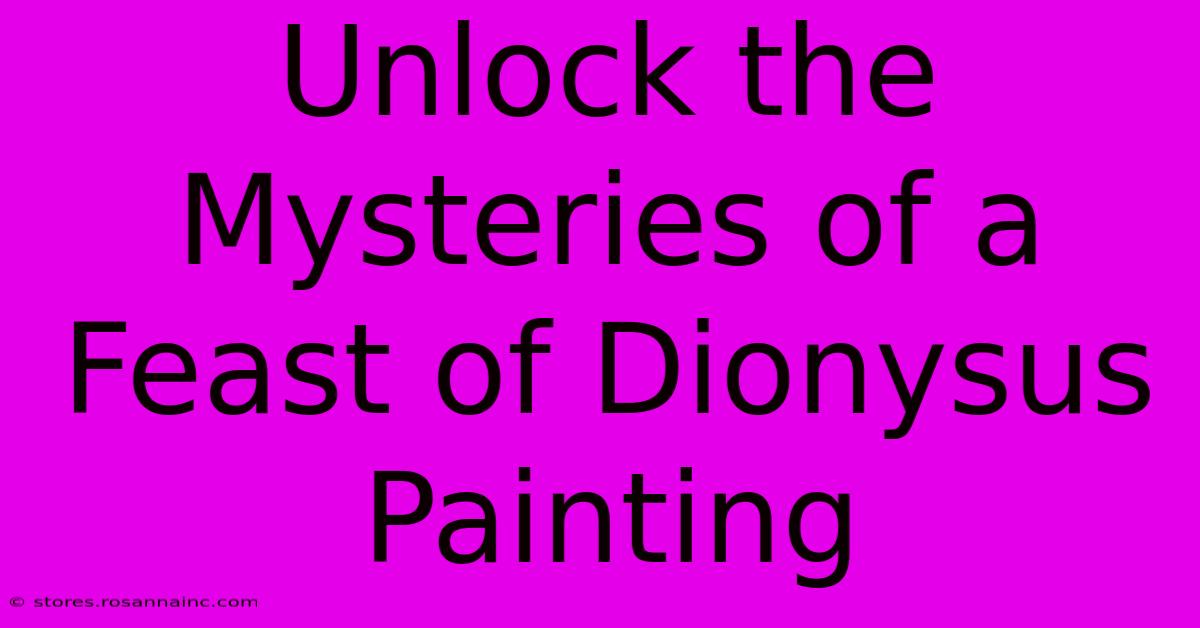Unlock The Mysteries Of A Feast Of Dionysus Painting

Table of Contents
Unlock the Mysteries of a Feast of Dionysus Painting
The vibrant, often chaotic, scenes depicting feasts of Dionysus have captivated art lovers for centuries. These paintings, brimming with symbolism and hidden meanings, offer a fascinating glimpse into ancient Greek religion and culture. But how can we truly unlock their mysteries? This article will delve into the key elements to look for when interpreting these captivating works of art, helping you appreciate their rich layers of meaning.
Decoding the God of Wine and Revelry
Dionysus, the Greek god of wine, fertility, theatre, and religious ecstasy, is the central figure in these feasts. Understanding his multifaceted nature is crucial to interpreting the paintings. He's not simply a party-loving deity; he represents the intoxicating power of nature, the cyclical rhythms of life and death, and the ecstatic release from societal norms. Identifying Dionysus in the artwork is often the first step. He might be depicted as a youthful, handsome god, or as an older, more majestic figure, sometimes with ivy or grape leaves entwined in his hair. Look for attributes associated with him:
- Thyrsus: A staff topped with a pine cone, representing fertility and divine power.
- Cantharus: A two-handled drinking cup, symbolizing the intoxicating nature of wine.
- Panther or Leopard: These animals were often associated with Dionysus and symbolized his untamed, wild nature.
The Revelers: More Than Just Partygoers
The figures surrounding Dionysus are not mere background characters; they are essential to the narrative. These maenads, female followers of Dionysus, often depicted in a frenzied state of ecstatic dance and revelry, represent the untamed power of nature and feminine energy. Satyrs, half-human, half-goat creatures, embody lustful abandon and the chaotic energy of the natural world. Their actions, expressions, and interactions within the painting communicate aspects of the Dionysian experience:
- Dancing: Represents ecstatic release and connection to the divine.
- Drinking: Symbolizes indulgence, abandon, and the blurring of boundaries between the human and divine.
- Music: Music played a significant role in Dionysian rituals, further emphasizing the ecstatic and ritualistic nature of the feast.
Symbolism in the Setting
The setting itself holds significant clues. Are the revelers in a bucolic landscape, amidst vineyards and nature's abundance, or in a more structured, architectural setting? The choice of location significantly impacts the interpretation. A natural setting emphasizes the wild, untamed aspects of Dionysus's power, whereas a structured setting might suggest a more controlled, ritualistic aspect of the celebration. Furthermore, consider the use of light and color. Vibrant, intense colors often convey the ecstatic energy of the feast, while darker, more muted tones may suggest a more somber or introspective aspect of Dionysian experience.
Beyond the Surface: Uncovering Deeper Meanings
Don't just focus on the literal depiction. These paintings are often allegorical, communicating broader themes about life, death, and the human condition. Consider the following:
- The relationship between order and chaos: The juxtaposition of structured elements and chaotic revelry can highlight the tension between societal norms and the intoxicating power of nature.
- The cyclical nature of life and death: The abundance of grapes and wine might symbolize the cyclical nature of life, death, and rebirth.
- The duality of human experience: The presence of both ecstatic joy and potential danger in the scenes emphasizes the complex duality of human experience.
By carefully analyzing the individual elements and their relationships, we can begin to unlock the deeper meanings embedded within these captivating depictions of the Feast of Dionysus. Remember that interpretation is subjective and there is no single "correct" reading; engaging with these paintings is an ongoing process of discovery and appreciation. Each viewing reveals new layers of meaning, encouraging us to explore the enduring power and mystery of Dionysus and his revelatory feasts.

Thank you for visiting our website wich cover about Unlock The Mysteries Of A Feast Of Dionysus Painting. We hope the information provided has been useful to you. Feel free to contact us if you have any questions or need further assistance. See you next time and dont miss to bookmark.
Featured Posts
-
Health Minister Gwynne Fired Over Texts
Feb 09, 2025
-
Gwynne Sacked Whats App Messages Leak
Feb 09, 2025
-
Unlock The Mystery Of The F Sharp Minor Scale
Feb 09, 2025
-
Ufc 312 Livestream How To Watch Free
Feb 09, 2025
-
Beye Brille Rennes Bat Saint Etienne
Feb 09, 2025
